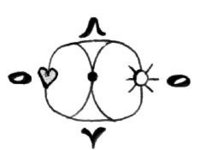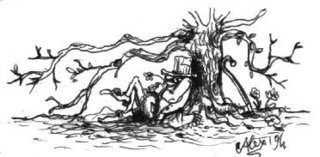Lara: Difference between revisions
m (→Grammar) |
|||
| (8 intermediate revisions by 4 users not shown) | |||
| Line 8: | Line 8: | ||
The [[Wikipedia:accent|accent]] is always on the penultimate syllable. | The [[Wikipedia:accent|accent]] is always on the penultimate syllable. | ||
[[Wikipedia:noun|Nouns]] always end with ''-a'', [[ | [[Wikipedia:noun|Nouns]] always end with ''-a'', [[adjective]]s and [[adverb]]s always with ''-i''. It needs only to add ''-s'' to the word in order to obtain the [[plural]]. | ||
The [[article]] doesn’t exist. | The [[article]] doesn’t exist. | ||
| Line 20: | Line 20: | ||
== '''Examples''' == | == '''Examples''' == | ||
=== "Zizi grumi" - ''Syuba''=== [[Image:VecchioRiccoLara.jpg|320px|right]] | === '''"Zizi grumi"'''-''Syuba'' === | ||
[[Image:VecchioRiccoLara.jpg|320px|right]] | |||
''Zizi grumi sen pyuka bolyun u wafa i gomen oye gume kora. Mati meden tawta i katen pu gruvi byeli fita kin gungi stifas pamel grâ. Sa glaen ye huma in e tiel: “Ai o lwi luki kapir goi grâ i lâ ku pyuka i kinkir dri fidas tu stifas sin mizi fita”. Ni glâ somen su tien imi ga. Esi planyen su gi tias i hota tuen ye hogas su hali fiva nu bora i vyuvas. Ami luhaken ga e luk’i dri. Su mami naka hunen ga i zari fiba yuen u šofi tlas. Huen fita i pelen ku pyuka. U tai maen gume balali pra. Upi gruvi fita, hunel ga droi i gili toga. Sa blaka zizin grumi. Trifa melen ni fiba lonen pu fita yu ti pa.'' | ''Zizi grumi sen pyuka bolyun u wafa i gomen oye gume kora. Mati meden tawta i katen pu gruvi byeli fita kin gungi stifas pamel grâ. Sa glaen ye huma in e tiel: “Ai o lwi luki kapir goi grâ i lâ ku pyuka i kinkir dri fidas tu stifas sin mizi fita”. Ni glâ somen su tien imi ga. Esi planyen su gi tias i hota tuen ye hogas su hali fiva nu bora i vyuvas. Ami luhaken ga e luk’i dri. Su mami naka hunen ga i zari fiba yuen u šofi tlas. Huen fita i pelen ku pyuka. U tai maen gume balali pra. Upi gruvi fita, hunel ga droi i gili toga. Sa blaka zizin grumi. Trifa melen ni fiba lonen pu fita yu ti pa.'' | ||
| Line 31: | Line 32: | ||
<font face="Book Antiqua"><font size=3>1 Dai rava | <font face="Book Antiqua"><font size=3>1 Dai rava den pli pi tega in imi blas. | ||
2 Peas su felle yu faga hegen tavya du kura nu Senayros i tai staken. | <font face="Book Antiqua"><font size=3>2 Peas su felle yu faga hegen tavya du kura nu Senayros i tai staken. | ||
3 Ken pitì: "Ales, pes sdugas i hures su râ". Sdug'aden ens gu tekla i gagya gu rora. | <font face="Book Antiqua"><font size=3>3 Ken pitì: "Ales, pes sdugas i hures su râ". Sdug'aden ens gu tekla i gagya gu rora. | ||
4 | <font face="Book Antiqua"><font size=3>4 Yai ey ken: "Ales, talles mara i vuna kin yuva pames bora i pes ons aka vu mi ga vuhe lu dai grâ". | ||
5 Ni Pia uyen se mara i vuna peas | <font face="Book Antiqua"><font size=3>5 Ni Pia uyen se mara i vuna peas men talle. | ||
6 Pia ken: "Sai, ey pli pi fora i de pli pi tega; s'anda nyen | <font face="Book Antiqua"><font size=3>6 Pia ken: "Sai, ey pli pi fora i de pli pi tega; s'anda yanka nyen i yoi ta ey dike pe mi ens mimasi. | ||
7 Igi oy uyes i beges yen | <font face="Book Antiqua"><font size=3>7 Igi oy uyes i beges tega yen gai pi nwi netes mitin tega". | ||
8 Pia vuhen nes u tai lu dai grâ in ey nwi tallen mara. | <font face="Book Antiqua"><font size=3>8 Pia vuhen nes u tai lu dai grâ in ey nwi tallen mara. | ||
9 Sovi aon Babelus, Pia su begen tai tega nu dai rava in u tai vuhen nes lu dai grâ. | <font face="Book Antiqua"><font size=3>9 Sovi aon Babelus, Pia su begen tai tega nu dai rava in u tai vuhen nes lu dai grâ. | ||
</font face></font size> | </font face></font size> | ||
The complete grammar is available in the [http://it.geocities.com/alexped/ official web-site of the Lara language] | The complete grammar is available in the [http://it.geocities.com/alexped/indexengl.html official web-site of the Lara language] | ||
Other examples of Lara language texts are available in [http://wikisource.org/wiki/Main_Page:Lara Wikisource] | Other examples of Lara language texts are available in [http://wikisource.org/wiki/Main_Page:Lara Wikisource] | ||
The [http://lara-language.wikispaces.com/ Lara Cultural Project] on Wikispace | |||
[[Category:A priori conlangs]] | [[Category:A priori conlangs]] | ||
[[Category: Artlangs]] | |||
[[Category: Conlangs]] | |||
Latest revision as of 01:08, 29 May 2013
Lara is an artistic fictional language began in 1991 by Alex-Lexa. Initially it was created for amusement, but at present it has a vocabulary of more than 7000 words and a complete grammar.
Grammar
The salient characteristic of the grammar is extreme simplicity, with the aim of making the language easy to learn.
Most of the words consist of only 2 syllables. The alphabet consists of 27 letters. Pronunciation is as in Latin except for č (or ch= chinese), k (= kiss), j (= french g), h (always to be aspirate), q (= quality), š (or sh= show), y (short i= plain) and w (short u= wonder).
The accent is always on the penultimate syllable.
Nouns always end with -a, adjectives and adverbs always with -i. It needs only to add -s to the word in order to obtain the plural.
The article doesn’t exist.
Also the verb "to be" is almost always omitted.
Cultural aspects
At present a Lara Language Cultural Association exists, open to everyone. By the active collaboration and creativity of its members, it sets the goal to create a new fantasy world, with its own fantasy culture and fantasy people.
A Lara philosophy is already widely developed. It has a peculiar symbol (see figure at side) and is based on the comparison between the grammatical, phonetic and syntactical simplicity of the language, that leads to serenity (=moba) of thinking and of its expression, and nature simplicity that leads to serenity of the spirit. On the base of this concept, brief tales were produced (the Syubas), real allegories the aim of which is to determine a condition of mind serenity through the lecture of an essential narration, characteristic of the allegory, in a so called natural language. You find an example of Syuba in the following section.
Examples
"Zizi grumi"-Syuba
Zizi grumi sen pyuka bolyun u wafa i gomen oye gume kora. Mati meden tawta i katen pu gruvi byeli fita kin gungi stifas pamel grâ. Sa glaen ye huma in e tiel: “Ai o lwi luki kapir goi grâ i lâ ku pyuka i kinkir dri fidas tu stifas sin mizi fita”. Ni glâ somen su tien imi ga. Esi planyen su gi tias i hota tuen ye hogas su hali fiva nu bora i vyuvas. Ami luhaken ga e luk’i dri. Su mami naka hunen ga i zari fiba yuen u šofi tlas. Huen fita i pelen ku pyuka. U tai maen gume balali pra. Upi gruvi fita, hunel ga droi i gili toga. Sa blaka zizin grumi. Trifa melen ni fiba lonen pu fita yu ti pa.
Translation: "The old rich man" (Syuba)
An old rich man saw a hill sorrounded by a wood and liked to climb it to watch at the panorama. Soon he felt exhaustion and sat down under an old bent tree the skeletal branches of which touched the ground. This saddened his heart and he thought: "If I was still young I would bring good earth and water up the hill and tie up the branches of this poor tree with strong poles". But his sadness increased since he thought over himself. So he fell asleep with this thoughts and his breath filled with the fresh smell of the sky and the flowers. When he woke up again he was young and strong. Being wondering he stood up and a diamond ring slipped off his restless fingers. He said goodbye to the tree and ran up the hill. He could watch at the wonderful nature from above. A mighty green oak rised at the place of the tree. This is the story of the old rich man. The magpie passed by but the ring remained under the tree since then.
Babel Text (Genesis 11:1-9)
1 Dai rava den pli pi tega in imi blas.
2 Peas su felle yu faga hegen tavya du kura nu Senayros i tai staken.
3 Ken pitì: "Ales, pes sdugas i hures su râ". Sdug'aden ens gu tekla i gagya gu rora.
4 Yai ey ken: "Ales, talles mara i vuna kin yuva pames bora i pes ons aka vu mi ga vuhe lu dai grâ".
5 Ni Pia uyen se mara i vuna peas men talle.
6 Pia ken: "Sai, ey pli pi fora i de pli pi tega; s'anda yanka nyen i yoi ta ey dike pe mi ens mimasi.
7 Igi oy uyes i beges tega yen gai pi nwi netes mitin tega".
8 Pia vuhen nes u tai lu dai grâ in ey nwi tallen mara.
9 Sovi aon Babelus, Pia su begen tai tega nu dai rava in u tai vuhen nes lu dai grâ.
The complete grammar is available in the official web-site of the Lara language
Other examples of Lara language texts are available in Wikisource
The Lara Cultural Project on Wikispace

